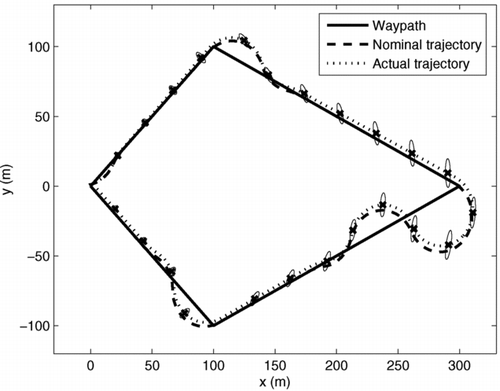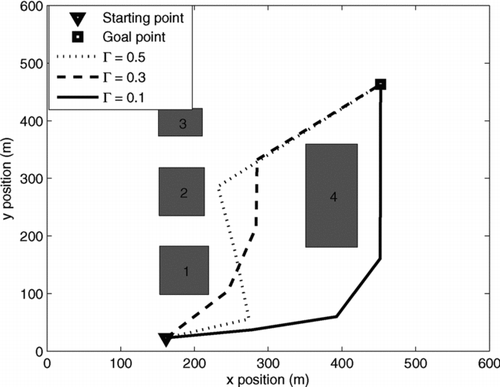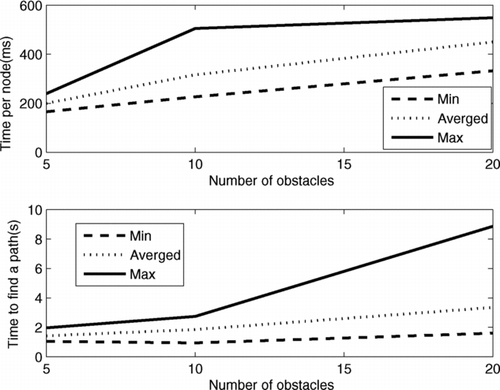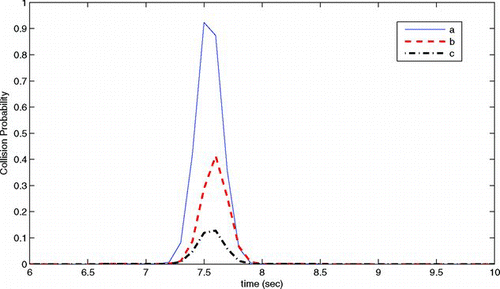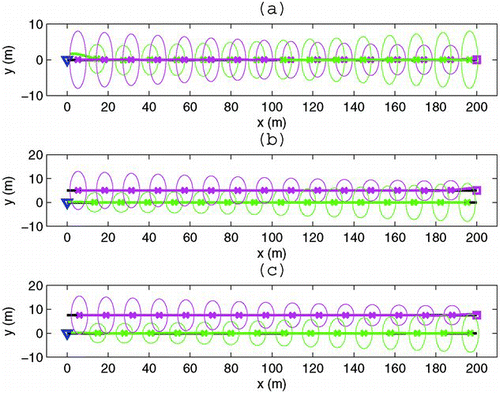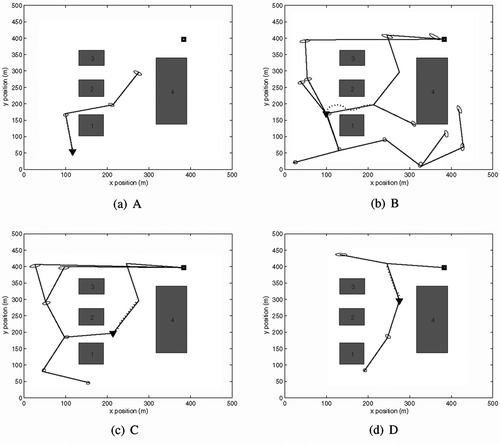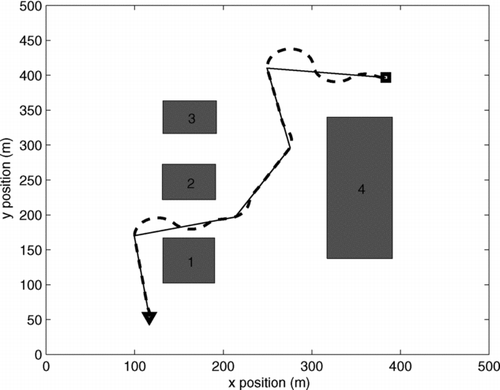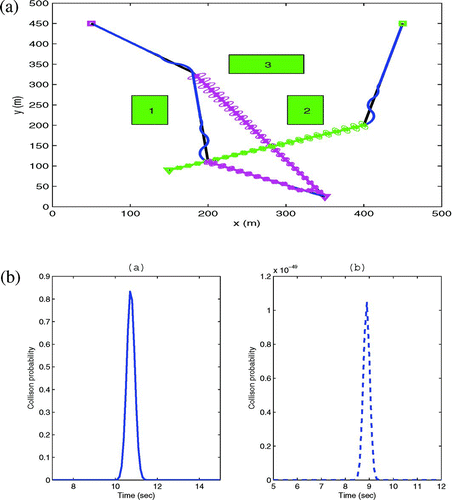Abstract
In this paper, a multi-agent motion planner is developed for nonlinear Gaussian systems using a combination of probabilistic approaches and a rapidly exploring random tree (RRT) algorithm. A closed-loop model consisting of a controller and estimation loops is used to predict future distributions to manage the level of uncertainty in the path planner. The closed-loop model assumes the existence of a feedback control law that drives the actual system towards a nominal system. This ensures the uncertainty in the evolution does not grow significantly and the tracking errors are bounded. To trade conservatism with the risk of infeasibility and failure, we use probabilistic constraints to limit the probability of constraint violation. The probability of leaving the configuration space is included by using a chance constraint approach and the probability of closeness between two agents is imposed using an overlapping coefficient approach. We augment these approaches with the RRT algorithm to develop a robust path planner. Conflict among agents is resolved using a priority-based technique. Numerical results are presented to demonstrate the effectiveness of the planner.
1. Introduction
Motion planning is the key to the success of missions involving autonomous vehicles (AVs), which have to deal with different forms of uncertainties associated with perception, localisation and situation awareness. The motion planning algorithms must predict and take account of disturbances to identify robust paths. The real world is full of uncertainty and AVs are subject to physical constraints; therefore, generating de-conflicting robust paths in real time, for multi-agent systems in dynamic uncertain environments, is a challenging task that we address in this paper. In systems where the uncertainties are bounded, robustness can be achieved by constraint tightening to ensure that states do not leave the feasible spaces (Gossner, Kouvaritakis, & Rossiter, Citation1997; Kuwata, Richards, & How, Citation2007). If the disturbance is unbounded, probabilistic approaches can be considered, which limit the violation probability to a specific value (Blackmore, Citation2006; Ono & Williams, Citation2008). We will use such an approach to design probabilistically robust paths.
Chance constraints have been used in stochastic programming and stochastic receding horizon control (RHC) (Blackmore, Citation2006; Li, Wendt, & Wozny, Citation2002; Pepy & Lambert, Citation2006; van Hessem, Citation2004; Yan & Bitmead, Citation2005) and they have recently received attention to stochastic path planning problems because of their ability to provide a trade-off between meeting the constraints and infeasibility. Blackmore Citation(2006) developed a probabilistic path planning algorithm, under the assumptions of Gaussian noise, to design an optimal sequence of control inputs for a linear system in a non-convex environment such that the probability of constraint violation with an obstacle was upper bounded. This was done using a disjunction of linear chance constraints. The key step of the approach was to convert chance constraints into deterministic constraints by constraint tightening and then to solve the problem using a standard deterministic optimal solver. Recently, extensions to the above approach have been proposed by Blackmore and Ono Citation(2009). Concurrent work has extended the chance constraint optimisation framework to consider other kinds of uncertainty, such as collision avoidance between uncertain agents (Du Toit & Burdick, Citation2011).
When an AV is operating in a dynamic environment, it has to avoid dynamic as well as static obstacles due to the presence of other AVs. This imposes restrictions on the positions of AVs in space and time. Lambert, Gruyer, and St. Pierre Citation(2008) proposed a formulation to compute the probability of collision, which accounts for both robot and obstacle uncertainty, and this was later generalised in Du Toit and Burdick Citation(2011). Typically, probabilistic formulations are solved using optimisation algorithms, such as mixed-integer linear programs or constrained nonlinear programs. For motion planning problems (MPPs) involving complex dynamics and/or high dimensional configuration spaces, the computational complexity of the optimisation algorithm is not scalable. For such complex problems, sampling-based approaches have been demonstrated to have several advantages; see for example RRTs (LaValle, Citation2006). However, the RRT does not explicitly incorporate uncertainty. Recently, efforts have been made to extend the RRT algorithm to an uncertain environment (Fulgenzi, Tay, Spalanzani, & Laugier, Citation2008; Kewlani, Ishigami, & Iagnemma, Citation2009; Melchior & Simmons, Citation2007). In this paper, we also propose an extension of the RRT algorithm to handle uncertainty in dynamic environments.
The paper is based on a chance constraint formulation presented in Blackmore, Li, and Williams Citation(2006). The formulation was combined with an RRT algorithm in our previous work (Kothari & Postlethwaite, Citation2013) to develop a computationally efficient path planning algorithm for a single vehicle system. Concurrently, in Vitus and Tomlin Citation(2011), the work of Blackmore et al. Citation(2006) was extended to manage closed-loop uncertainty for linear Gaussian systems. Our paper further extends the work to nonlinear Gaussian systems and furthermore makes it applicable to multi-agent systems through the use of another probabilistic approach, called the overlapping coefficient. Combining these approaches with the RRT algorithm, a robust computationally efficient path planner for multi-agent systems is developed to determine de-conflicting paths in uncertain environments.
The rest of the paper is organised as follows. The motion planning problem is formally stated in Section 2. Section 3 presents mathematical details required to evaluate probabilistic constraints under the assumption of Gaussian noise. Section 4 develops a real-time robust distributed motion planning algorithm by extending an RRT algorithm and combining probabilistic approaches. Numerical results are presented in Section 5 to show the efficacy of the algorithm and concluding remarks are given in Section 6.
2. Problem formulation
Consider the following discrete-time nonlinear stochastic system for the ith agent
The system given in (Equation1)–(Equation2) is subject to two forms of uncertainty: (i) localisation uncertainty in the initial state x
0 and (ii) process and measurement noise corresponding to the model uncertainty and external disturbances, or some combination of these, as long as they are independent. We assume that the covariances on the process and measurement noise are time-invariant, such that ![]() . There are also constraints acting on the system. These are assumed to be decoupled, and can be represented as
. There are also constraints acting on the system. These are assumed to be decoupled, and can be represented as
If we assume that each agent has a common objective, namely to reach its corresponding goal region ![]() in minimum time, then the planning problem for the ith agent can be written as
in minimum time, then the planning problem for the ith agent can be written as
Problem 1 (near minimum time motion planning)
Given the initial state x
0 and constraint sets ![]() and
and ![]() , compute the input control sequence
, compute the input control sequence ![]() that minimises
that minimises
3. Mathematical details
This section details how to evaluate a-priori closed-loop distributions of the system given in (Equation1)–(Equation2) and then shows how to evaluate probabilistic constraints (Equation4) and (Equation5) for the given uncertain system. The explicit expression for the distributions is derived using the Kalman filter theory and is used in predicting future distributions of the sampled trajectories by the path planner. By anticipating and accounting for future information, the closed-loop motion planning algorithm can manage uncertainty associated with the system evolution and can trade off conservatism in the path planner using probabilistic constraints. In a stochastic environment, constraint satisfaction (corresponding to obstacle avoidance and inter-agent collision) cannot be guaranteed for all realisations of the states. Hence, in order to achieve a desired trade-off there is a need to limit the probability of constraint violation (for constraints (Equation4) and (Equation5)). The evaluation of the probabilistic constraint (Equation4) is done using the approach of chance constraints (Blackmore, Citation2006; Luders, Kothari, & How, Citation2010; Ono & Williams, Citation2008), whereas the evaluation of probabilistic constraint (Equation5) is done using the approach of overlapping coefficients (Lu, Smith, & Good, Citation1989).
3.1 A-priori closed-loop distributions
For a nonlinear Gaussian system, the unavailability of future measurements means it is hard to compute a-priori closed-loop distributions. One can consider multiple realisations of future measurements and can evaluate closed-loop distributions, but such an approach requires Monte Carlo simulations that are computationally intractable. To address this issue, we assume that there exists a nominal system corresponding to that given in (Equation1)–(Equation2) as
3.2 Chance constraint
The motion planning problem requires that the vehicle does not leave some feasible region and therefore that the vehicle does not collide with any other obstacle while travelling from its starting location to its final position. Let ![]() be the feasible region and
be the feasible region and ![]() be the probability that the vehicle leaves the feasible region during the mission. The motion planning problem requires that
be the probability that the vehicle leaves the feasible region during the mission. The motion planning problem requires that ![]() is less than or equal to Δ as given in (Equation4). Here, we detail the main steps of the chance constraint formulation presented in Blackmore and Ono Citation(2009), Luders et al. Citation(2010).
is less than or equal to Δ as given in (Equation4). Here, we detail the main steps of the chance constraint formulation presented in Blackmore and Ono Citation(2009), Luders et al. Citation(2010).
Let us assume that an obstacle is represented by the conjunction of n o linear constraints. With this, the probability of a constraint violation by the ith vehicle is written as
3.3 Overlapping probability
In this section, we describe how to compute the probability of two given multivariate distributions overlapping. The probability of collision (overlapping) can be computed as
We next show how to compute this measure of similarity between two multivariate normal distributions in closed form using the approach of overlapping coefficients. Let
Lemma 1
The quantities J and G lie within the ranges 0 ≤ J ≤ 1 and 0 ≤ G ≤ 1.
Proof
Let us consider two measurable functions F ≥ 0 and H ≥ 0, then
Next, let us consider
Next, in the process of computing an expression for these measures, we evaluate the integral in (Equation31) for the given f 1(x) and f 2(x).
Lemma 2
Let distributions of the ith and jth agents be given as ![]() and
and ![]() and assume
and assume ![]() , Σ1 = Σ
i
xt
,
, Σ1 = Σ
i
xt
, ![]() and Σ2 = Σ
j
xt
. Then
and Σ2 = Σ
j
xt
. Then
Proof
The product of Gaussian distributions is a weighted Gaussian (e.g. Petersen & Pedersen, Citation2008), and therefore
In this work, we choose Pianka’s measure (Lu et al., Citation1989) to compute the overlap probability, which corresponds to G(1,1). We define ![]() for clarity and then the probability of collision is given as
for clarity and then the probability of collision is given as
4. Algorithms
The mathematical details presented in the previous section are generic and can be used with any path planning algorithm to design a probabilistically robust path planner. The RRT algorithm has been demonstrated to be a successful planning algorithm for complex real-world systems and allows a designer to choose problem-specific heuristics to bias the growth of the tree to guide and improve the search. Motivated by this, we will use the RRT algorithm in conjunction with a number of heuristics to develop a computationally efficient decentralised robust motion planning algorithm for multi-agent systems. In the proposed algorithm, each vehicle operates in a decentralised manner and uses a look-ahead strategy to find its own path in real time. Furthermore, each vehicle cooperates with other vehicles when they are within communication range to avoid conflicts. A strategy based on a priority criterion is considered for conflict resolution.
4.1 Tree expansion
This section details some key steps for exploring the environment quickly, combining RRT with the chance constraint approach to identify robust paths for each vehicle without considering other vehicles in the environment. The original RRT algorithm (LaValle, Citation2006) determines an admissible path by growing a tree incrementally from a starting location (node) to a goal location. A node’s likelihood of being selected to grow the tree is proportional to its Voronoi region for a uniform sampling distribution. As a result, the RRT algorithm is naturally biased towards rapid exploration of the state space. The RRT algorithm allows us to choose problem specific heuristics that can bias the growth of the tree and hence enable it to converge faster. This feature has been extensively exploited and several variations of the original RRT algorithm have been proposed to solve different problems. In the probabilistic framework, the RRT algorithm is extended to grow a tree of state distributions that are known to satisfy an upper bound on the probability of constraint violation. The basic steps are given in Algorithm 1. The heuristics deployed in Algorithm 1 are briefly explained below. More details on the RRT can be found in LaValle Citation(2006), Kothari and Postlethwaite Citation(2013), Luders et al. Citation(2010) and Kuwata et al. Citation(2009).
The tree starts growing after setting the starting position as the root of the tree (line 1). The expansion steps continue until the time to expand runs out (lines 2–24). In each iteration, a random sample is drawn (line 3) according to some sampling strategy (e.g. global exploration and biased exploration). A small bias towards the goal aids in pulling the tree towards that goal. For the chosen sample, the N nearest nodes are identified (line 4) using a predefined metric and efforts are made to connect them to the sample. In this process, potential candidate nodes are generated (line 6) from a nearest node to the chosen sample to generate reference paths/waypaths that can be followed by the vehicle. The next step is to predict distributions of the vehicle using the closed-loop model for a given waypath from the nearest neighbour to the potential node using the theory presented in Section 3. This requires a path following control law to drive the vehicle close to the reference path. In this work, we use a combined pursuit plus line-of-sight guidance law to generate nominal control commands u*
t
(Kothari, Postlethwaite, & Gu, Citation2009) (line 10), for disturbance-free dynamics (Equation10)–(Equation11). And, using a similar approach, we design another control law that keeps the actual vehicle close to the nominal trajectory. The details of this are presented later in the paper. The closed-loop prediction of future distributions is obtained by running the nominal system and the augmented system with the path following control laws until ![]() or the path becomes probabilistically infeasible (lines 9–14). Note that the algorithm maintains three separate trees, one corresponding to the reference trajectory, one to the nominal trajectory generated from disturbance-free dynamics and the final one for a simulated trajectory generated from the actual system that contains information about the closed-loop distributions. The function FIND_STATE in step 8 retrieves initial conditions that are stored while growing the tree and forward simulations are performed using these initial conditions.
or the path becomes probabilistically infeasible (lines 9–14). Note that the algorithm maintains three separate trees, one corresponding to the reference trajectory, one to the nominal trajectory generated from disturbance-free dynamics and the final one for a simulated trajectory generated from the actual system that contains information about the closed-loop distributions. The function FIND_STATE in step 8 retrieves initial conditions that are stored while growing the tree and forward simulations are performed using these initial conditions.
After predicting the state distribution (![]() and Σ
t
) at each time step t, probabilistic feasibility is evaluated using inequalities (Equation27). The criterion for a probabilistically valid path is that the disjunction of the constraints
and Σ
t
) at each time step t, probabilistic feasibility is evaluated using inequalities (Equation27). The criterion for a probabilistically valid path is that the disjunction of the constraints ![]() should hold (i.e. at least one constraint should be satisfied) for all
should hold (i.e. at least one constraint should be satisfied) for all ![]() and for all l = 1, … , B. If the predicted path is found feasible, then an attempt is made to connect the extended node directly to
and for all l = 1, … , B. If the predicted path is found feasible, then an attempt is made to connect the extended node directly to ![]() at line 18. This allows the algorithm to find quickly a feasible path to
at line 18. This allows the algorithm to find quickly a feasible path to ![]() . In addition to this, a branch and bound method is used to avoid growing the whole tree as much as possible by growing only the most promising nodes of the tree. The more promising nodes are identified by maintaining two estimates of the optimal cost-to-go from each node to the goal region (Frazzoli, Dahleh, & Feron, Citation2002). The lower-bound cost-to-go under-approximates the cost using the Euclidean norm metric
. In addition to this, a branch and bound method is used to avoid growing the whole tree as much as possible by growing only the most promising nodes of the tree. The more promising nodes are identified by maintaining two estimates of the optimal cost-to-go from each node to the goal region (Frazzoli, Dahleh, & Feron, Citation2002). The lower-bound cost-to-go under-approximates the cost using the Euclidean norm metric ![]() , which ignores dynamic and/or avoidance constraints. The upper-bound cost-to-go identifies the lowest-cost path from the root to the goal through the node in question, taking the value +∞ if no path to the goal has yet been found. The branch and bound method is executed when at least one path to the goal is identified. Additionally, a branch-and-bound scheme is used to prune portions of the tree of unpromising nodes, whose lower-bound cost-to-go is larger than the upper-bound cost-to-go of an ancestor. This is because none of these nodes could possibly lead to a better solution than the complete feasible solution (Frazzoli et al., Citation2002).
, which ignores dynamic and/or avoidance constraints. The upper-bound cost-to-go identifies the lowest-cost path from the root to the goal through the node in question, taking the value +∞ if no path to the goal has yet been found. The branch and bound method is executed when at least one path to the goal is identified. Additionally, a branch-and-bound scheme is used to prune portions of the tree of unpromising nodes, whose lower-bound cost-to-go is larger than the upper-bound cost-to-go of an ancestor. This is because none of these nodes could possibly lead to a better solution than the complete feasible solution (Frazzoli et al., Citation2002).
This completes the steps in tree expansion. The motion planner allocates a certain duration, t a , for tree expansion. Based on the tree built in the interval, a path is chosen to be followed. By the time an agent follows a portion of this path, the tree can be further expanded and a complete path to the goal location can be found. Next, we develop a distributed path planning algorithm for generating de-conflicting paths.
4.2 Robust distributed path planner
For environments that are dynamic and uncertain, the RRT may need to keep growing during the path following to account for changes in situational awareness. In this section, we propose a motion planning algorithm for a team of cooperative agents by embedding the RRT algorithm in a framework that manages interactions among different agents and uses a coordination strategy to resolve conflicts. The strategy allows each agent to search for lower cost paths independently and manages the order in which an agent replans based on the priority of finding a new path. Because of this, the resultant algorithm preserves the benefits of a single agent system while avoiding conflicts. The steps are presented in Algorithm 2.
Algorithm 2 Multi-agent RRT algorithm
Initially, the root of the search tree is created by assigning the starting position of the vehicle. Then for the given map and starting and goal positions, the tree of probabilistically feasible trajectories is grown for the given time, t p (line 2). If paths to the goal are found in this interval, then the best path is selected for execution. Otherwise, a branch of the trajectory is selected for execution based on a heuristic (lines 4–8). While executing the selected path, the tree continues to be grown either in search of lower cost paths or complete paths to the goal location. If there are any agents within communication range, then they have to coordinate to generate de-conflicting paths. For this coordination, each agent has to share its plan with its neighbours. Once an agent receives the plans of other agents, it first determines whether the received plans are in conflict with its own plan and if so deploys a conflict resolution strategy. The manner in which each agent resolves conflicts is controlled by a coordination strategy, which enables each agent sequentially to have a conflict-free path. The processes involved in conflict resolution are presented next.
Coordination strategy: Once a conflict is detected among neighbouring agents, each agent creates its own conflict set ![]() and processes it sequentially to resolve conflicts. The conflict resolution strategy is based on a priority criterion in which the agent with the highest (predefined) token number does not change its plan and the other agents have to change their plans in sequence to avoid conflicts. We assume that each agent holds a token number based on its priority and this is assigned by a higher level planner, the details of which are not covered in this work. The ith agent sorts
and processes it sequentially to resolve conflicts. The conflict resolution strategy is based on a priority criterion in which the agent with the highest (predefined) token number does not change its plan and the other agents have to change their plans in sequence to avoid conflicts. We assume that each agent holds a token number based on its priority and this is assigned by a higher level planner, the details of which are not covered in this work. The ith agent sorts ![]() in an descending order of priority and the sorted set is called
in an descending order of priority and the sorted set is called ![]() . In the next step, the algorithm compares the first element of the set
. In the next step, the algorithm compares the first element of the set ![]() with its own token number. If both are equal, then the ith agent does not need to find an alternative path. If they are not equal, then it has to find an alternative path. When the ith agent replans, it will need to take account of paths of agents with higher priorities compared to its own. This is because if it does not account for these paths and plans independently then it is possible that the new plan will be in conflict with the higher priority agents. In such a case, agents may get stuck indefinitely in resolving conflicts. If there are agents in
with its own token number. If both are equal, then the ith agent does not need to find an alternative path. If they are not equal, then it has to find an alternative path. When the ith agent replans, it will need to take account of paths of agents with higher priorities compared to its own. This is because if it does not account for these paths and plans independently then it is possible that the new plan will be in conflict with the higher priority agents. In such a case, agents may get stuck indefinitely in resolving conflicts. If there are agents in ![]() that have higher priorities, then the ith agent will not replan until it receives plans for all of these agents. After receiving plans from these agents, it includes them in a non-conflicting set called
that have higher priorities, then the ith agent will not replan until it receives plans for all of these agents. After receiving plans from these agents, it includes them in a non-conflicting set called ![]() and uses them while replanning. Once the ith agent finds a conflict-free path, it broadcasts this path to its neighbours so they can use it in replanning and conflict detection by agents that have lower priorities. In this way, the conflict resolution algorithm runs on each vehicle and provides conflict free paths for all vehicles.
and uses them while replanning. Once the ith agent finds a conflict-free path, it broadcasts this path to its neighbours so they can use it in replanning and conflict detection by agents that have lower priorities. In this way, the conflict resolution algorithm runs on each vehicle and provides conflict free paths for all vehicles.
The conflict resolution process also involves generating de-conflicting paths. This can be achieved either by bypassing the conflict, generating a new path around the conflicting trajectory, or by selecting an alternative path from the existing tree, which is not in conflict. Once the conflict is resolved, the process of execution is continued until the vehicle reaches the goal region. In addition to this, whenever measurements are received, the tree is updated accordingly and any infeasible part of the tree is deleted.
5. Numerical results
In this section, we present numerical results to demonstrate the effectiveness of the proposed approach in efficiently computing paths for motion planning problems that satisfy probabilistic constraints. The performance of the proposed approach is demonstrated by three examples. The first example considers the closed-loop prediction of a nonlinear Gaussian system required to predict future trajectories. The second example considers offline performance of the path planner for a single vehicle system. This is useful to demonstrate computational performance. The final example demonstrates path planning capability for a multi-agent system.
5.1 System description
In order to evaluate probabilistic constraints there is a need to know the distribution of a vehicle’s state. As we are planning in advance, the vehicle’s future state is required to be known a priori. For this, we consider the following simple kinematic model for a vehicle,
The vehicle measures range and bearing with respect to a beacon placed at the origin and using these noisy measurements it localises itself. The measurements are sampled at each time step as follows,
5.2 Closed-loop prediction
Having defined the model of the system, we check the performance of the closed-loop prediction for path following. This is important to evaluate because the path planner predicts future trajectories for the sampled waypaths to check feasibility and these paths are only included in the tree when the predicted trajectories are deemed feasible. If the predictions are bad, then there is no way the path planner can perform better. For the nominal system, we assume there is no disturbance, this means η t = 0 and υ t = [0 0] T , ∀t in (Equation51) and (Equation52), respectively. Furthermore, we assume that these states are measurable. For a given reference path, the path following command is computed by combining pursuit guidance with line-of-sight guidance laws as follows (Kothari et al., Citation2009)
5.3 Offline performance
The objective of this subsection is to demonstrate the computational efficiency of the proposed path planning algorithm. We have reported a similar analysis for a linear Gaussian system in Kothari and Postlethwaite Citation(2013); however, that work does not consider a measurement model in the prediction. Here, we evaluate performance of the algorithm for similar scenarios as in Kothari and Postlethwaite Citation(2013). In the first set of simulations, we consider three cases for the scenario shown in with three risks of collision, Γ = 0.5, 0.3 and 0.1. shows the paths and it can be seen that when the risk of collision with any obstacle is reduced, the path moves away from the obstacles to maintain a safe distance.
In the second set of simulations, we show the distribution of the nodes during the expansion of the tree for two cases. For the same scenario as in the sample trees are now grown with Γ = 0.5 and 0.1 in and , respectively. We can make some key observations. The first observation is that in the first case the tree has nodes closer to the obstacles. This is because we have a less stringent requirement on safety compared to the second case. Second, it can also be seen that there are more uncertainty ellipses in the passage for the first case. We will now show that the algorithm scales up well with the number of obstacles.
Figure 3 Sample tree with Γ = 0.5 generated by the closed-loop RRT algorithm for a simple environment. Each node corresponds to the state distribution mean; a 2 − σ uncertainty ellipse is centred at each node. The mean is shown by ‘x’ in each ellipse
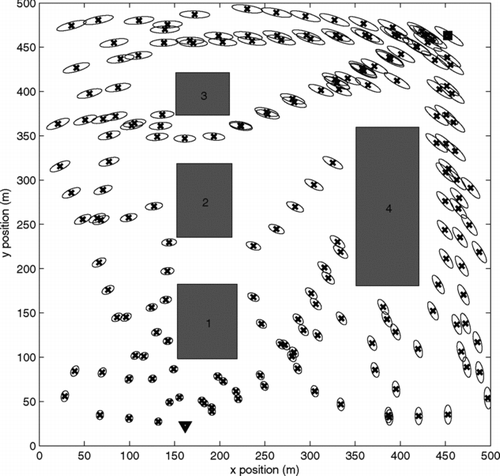
Figure 4 Sample tree with Γ = 0.9 generated by the closed-loop RRT algorithm for a simple environment
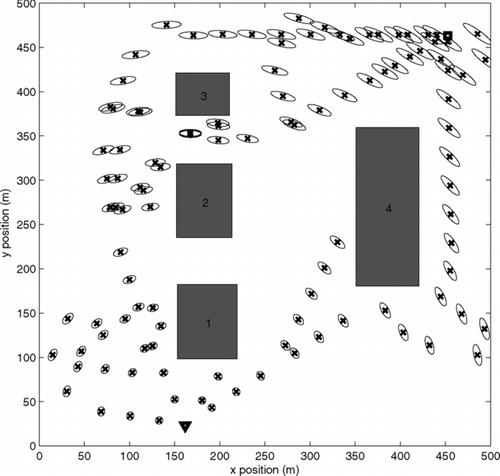
5.3.1 Computational performance
The computational complexity of the closed-loop RRT algorithm mainly depends on the number of obstacles. In this section, we show how the runtime of the proposed algorithm scales with the number of obstacles and we advocate the potential of the algorithm for use in real time. We consider the following six scenarios, with 10 trials performed for each scenario with randomly generated starting and goal locations:
(1) Five obstacles, closed-loop RRT with Γ = 0.5 | |||||
(2) Five obstacles, closed-loop RRT with Γ = 0.1 | |||||
(3) Ten obstacles, closed-loop RRT with Γ = 0.5 | |||||
(4) Ten obstacles, closed-loop RRT with Γ = 0.1 | |||||
(5) Twenty obstacles, closed-loop RRT with Γ = 0.5 | |||||
(6) Twenty obstacles, closed-loop RRT with Γ = 0.1 | |||||
The tree is grown until a probabilistically feasible path is found. summarises the minimum, maximum and average runtimes per node and per path, and the same data are plotted in . It can be seen from the figure that the minimum and average runtimes increase almost linearly with the number of obstacles, whereas the maximum runtimes show some marked changes. The analysis provides empirical evidence that the computational time needed for the closed-loop RRT scales approximately linearly with the number of obstacles. Hence, the algorithm would appear to be suitable for real-time applications.
Table 3 Simulation results, cluttered environment
Table 1 Tree expansion for each agent
Remark 1
The path planner works in a decentralised manner and the computational time needed for the closed-loop RRT scales approximately linearly with the number of obstacles as mentioned above. However, if there are many vehicles, they have to communicate to resolve conflicts. In the absence of constraints, the performance of the algorithm does not suffer. But in practice there will be limited bandwidth for communication and therefore the algorithm’s performance may deteriorate for large systems.
5.3.2 Overlapping probability measure
In this set of simulations, we compute overlapping probabilities for three difference cases where two vehicles are moving ‘towards’ each other with a vertical separation. shows the collision probability corresponding to the cases shown in . It can be seen that when the vehicles are at the same level, as shown in (a), the probability of collision is higher than when they are not, as in Figure (b) and, Figure (c), where the distributions are not overlapping significantly. Hence, we can specify a desired safe separation between vehicles by assigning a suitable probability of overlap.
5.4 Online implementation
In this subsection, we show how the tree grows in real time to find a path to a goal location while satisfying probabilistic constraints. The real-time implementation adopts a look-ahead strategy in which the tree is grown during the given time window and then the best branch from the existing tree is chosen for execution. In this example, the sample tree shown in (a) is grown for 0.5 sec and a branch is chosen using a heuristic if no path to the goal location is found. The heuristic selects a branch that has the least cost, the cost of the path so far combined with the lower-bound cost-to-go as described in Section 4. The algorithm explores the configuration space to find a complete path or paths with lower cost while tracking the current path. The decision to follow a new path can be made at different time instants based on the time window duration; however, in this example we allow the tree to expand until a vehicle finishes executing the current branch. This is because the vehicle is subject to a turn radius constraint and frequent turning may cause damage to the vehicle. However, the proposed framework allows flexible decision-making to suit the user. (b) shows the sample tree after execution of the first waypath. The algorithm finds several paths to the goal location and the minimum cost path is selected for execution. The process of exploration with emphasis on optimisation is continued until the vehicle reaches the goal location. (c) and (d) show sample trees after executing various waypaths. The searched path and tracked path are shown in . It can be seen that the vehicle stays away from the obstacles even during transitions, which are anticipated. Note that during motion the vehicle communicates with neighbouring vehicles, if they are within a communication range, to avoid conflicts. In the next scenario, we show how conflicts can be resolved.
In this set of simulations, we consider the case of two vehicles in conflict. The motion planning scenario is shown in (a) for two vehicles. Initially, probabilistically robust paths have been determined for each vehicle without considering the other vehicle in the environment; however, they appear to be in conflict. The conflict is resolved by forcing one vehicle to make a detour. The probability of collision with and without conflict is shown in (b). It can be seen when the conflict is resolved the probability of collision is very low (order of 10−48). This demonstrates the potential of the approach for determining paths while accounting for uncertainties.
6. Conclusions
In this paper, we have proposed an algorithm for multi-agent robust path planning in uncertain environments. The path planning process has to deal with two main types of uncertainties: (i) localisation uncertainty due to uncertainty in the initial state and process noise, and (ii) uncertainty in predicting future trajectories from current measurements. In order to take account of these uncertainties we have proposed a method that uses a closed-loop model to predict future information. The closed-loop model derives the most likely measurements and predicts a-priori distributions of the vehicle’s states. Since these distributions are more relevant than open-loop distributions, we have been able to manage the level of uncertainty in the path planning process. Because of this, the planned and executed paths are closer indicating that the planner effectively uses the anticipated information during the planning process.
Also, by introducing the probability constraints, it is possible to manage the feasibility of a solution. We use a chance constraint and the method of overlapping coefficients. The probability of feasibility can be used as a tuning parameter to adjust the level of conservatism in the planning process. Numerical results have been presented to demonstrate the algorithms. In future, the work will be extended to large systems (with many vehicles) where communication can be an issue if agents have to communicate to avoid conflicts. The framework can be further developed for multi-target tracking applications in uncertain environments.
References
- Blackmore , L . “ A probabilistic particle control approach to optimal, robust predictive control ” . In Proceedings of the AIAA Guidance, Navigation and Control Conference. 21–24 August 2006, Keystone, Colorado.
- Blackmore , L. and Ono , M . “ Convex chance constrained predictive control without sampling ” . In Proceedings of the AIAA Guidance, Navigation and Control Conference. 10–13 August 2009, Chicago, Illinois
- Blackmore , L. , Li , H. and Williams , B . “ A probabilistic approach to optimal robust path planning with obstacles ” . In Proceedings of the IEEE American Control Conference. 14–16 June 2006, Minneapolis, Minnesota.
- Du Toit , N. E. and Burdick , J. W. 2011 . Probabilistic collision checking with chance constraints . IEEE Transactions on Robotics , 27 ( 4 ) : 809 – 815 . doi: 10.1109/TRO.2011.2116190
- Frazzoli , E. , Dahleh , M. A. and Feron , E. 2002 . Real-time motion planning for agile autonomous vehicles . AIAA Journal of Guidance, Control, and Dynamics, , 25 ( 1 ) : 116 – 129 . doi: 10.2514/2.4856
- Fulgenzi , C. , Tay , C. , Spalanzani , A. and Laugier , C . “ Probabilistic navigation in dynamic environment using rapidly-exploring random trees and gaussian processes ” . In Proceedings of the IEEE International Conference on Intelligent Robots and Systems 1056 – 1062 .
- Gossner , J. R. , Kouvaritakis , B. and Rossiter , J. A. 1997 . Stable generalized predictive control with constraints and bounded disturbances . Automatica, , 33 ( 4 ) : 551 – 568 . doi: 10.1016/S0005-1098(96)00214-2
- Kewlani , G. , Ishigami , G. and Iagnemma , K . “ Stochastic mobility-based path planning in uncertain environments ” . In Proceedings of the IEEE/RSJ International Conference on Intelligent Robots and Systems IROS 2009 (pp. 1183–1189). 11–15 October 2009, St. Louis
- Kothari , M. and Postlethwaite , I. 2013 . A probabilistically robust path planning algorithm for UAVs using rapidly-exploring random trees . Journal of Intelligent & Robotic Systems, , 71 ( 2 ) : 231 – 253 . doi: 10.1007/s10846-012-9776-4
- Kothari , M. , Postlethwaite , I. and Gu , D. -W . “ Multi-UAV path planning in obstacle rich environments using rapidly-exploring random trees ” . In Proceedings of the 48th IEEE Conference on Decision and Control and 28th Chinese Control Conference. 16–18 December 2009, Shanghai.
- Kuwata , Y. , Richards , A. and How , J. 2007, July . Robust receding horizon control using generalized constraint tightening . Proceedings of the IEEE American Control Conference , : 4482 – 4487 . New York City, NY
- Kuwata , Y. , Teo , J. , Fiore , G. , Karaman , S. , Frazzoli , E. and How , J. P. 2009 . Real-time motion planning with applications to autonomous urban driving . IEEE Transactions on Control Systems Technology, , 17 ( 5 ) : 1105 – 1118 . doi: 10.1109/TCST.2008.2012116
- Lambert , A. , Gruyer , D. and Pierre , G . “ A fast Monte Carlo algorithm for collision probability estimation ” . In Proceedings of the 10th International Conference Control, Automation, Robotics and Vision ICARCV 2008 (pp. 406–411). 17–20 December 2008, Hanoi
- LaValle , S. M. and LaValle , S. M. 2006 . Planning algorithms (pp. 185–246). , Cambridge University Press . ). Sampling-based motion planning. In (Ed.),
- Li , P. , Wendt , M. and Wozny , G. 2002 . A probabilistically constrained model predictive next term controller . Automatica, , 38 ( 7 ) : 1171 – 1176 . doi: 10.1016/S0005-1098(02)00002-X
- Lu , R. , Smith , E. P. and Good , I. J. 1989 . Multivariate measures of similarity and niche overlap . Theoretical Population Biology, , 35 ( 1 ) : 1 – 21 . doi: 10.1016/0040-5809(89)90007-5
- Luders , B. , Kothari , M. and How , J. P . “ Chance constrained RRT for probabilistic robustness to environmental uncertainty ” . In Proceedings of the AIAA Guidance, Navigation, and Control Conference and Exhibit. 2–5 August 2010, Toronto.
- Melchior , N. A. and Simmons , R . “ Particle RRT for path planning with uncertainty ” . In Proceedings of the IEEE International Conference on Robotics and Automation. 10–14 April 2007, Roma.
- Ono , M. and Williams , B. C . “ An efficient motion planning algorithm for stochastic dynamic system with constraints on probability of failure ” . In Proceeding of the 23th AAAI Conference on Artificial Intelligence. Illinois.
- Pepy , R. and Lambert , A . “ Safe path planning in an uncertain-configuration space using RRT ” . In Proceedings of IEEE/RSJ Int Intelligent Robots and Systems Conference, (pp. 5376–5381). 9–15 October 2006, Beijing
- Petersen , K. B. and Pedersen , M. S. Matrix cookbook Retrieved from www.matrixcookbook.com
- Hessem , D. H. 2004 . Stochastic inequality constrained closed-loop model predictive control: with application to chemical process operation (doctoral dissertation). , Delft University Press, Delft .
- Vitus , M. P. and Tomlin , C. J . “ Closed-loop belief space planning for linear, gaussian systems ” . In Proceedings of the IEEE International Robotics and Automation (ICRA) Conference (pp. 2152–2159). 9–13 May 2011, Shanghai
- Yan , Y. and Bitmead , R. R. 2005 . Incorporating state estimation into model predictive control and its application to network traffic control . Automatica, , 41 : 595 – 604 . doi: 10.1016/j.automatica.2004.11.022
